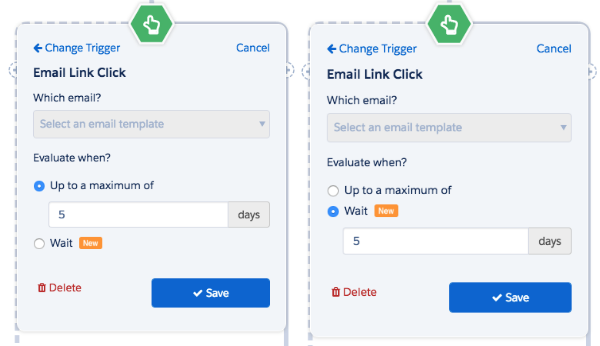In our last blog post, we told you ‘What’s new with Pardot’s Engagement Studio’. Well, now we’re here to offer our advice on what to be aware of when setting up your nurture programs in Engagement Studio.
How do prospects start the journey?
Determining who enters your Engagement Studio program is controlled by the recipient list and suppressions lists. When prospects are added to the recipient list, they are added to your Engagement Studio program. You can add multiple recipient lists, but should a prospect appear on more than one they will not be run through the Engagement Studio program twice. If a prospect appears on a suppression list then they will not be run through the program. Or if they appear on a suppression list after they’ve started the program, they will simply be removed at that point.
Both static lists and dynamic lists can be used within your Engagement Studio program. Ensure you consider when prospects are added to these lists (either through actions or rule-criteria) that the timing and messaging of the first step makes sense.
Business hours
Depending on the nature of your program and the expectations of your audience, you can choose to send emails in business hours or the next available business hour should the action occur outside of the specified times (10am-4pm, Monday to Friday).
Pause vs wait steps
Although it’s a great feature of Engagement Studio to be able to move prospects through a nurture program in real-time, it’s worth bearing in mind what journey you intend them to make before setting up your pause and wait steps.
Setting up actions and rules requires you to set a time period of either ‘Immediately’ or ‘Wait x number of days’ which means when prospects reach that step, the action will be taken or the rule evaluated either immediately or after a set period of time.
With triggers, you can set a ‘Wait period of up to x number of days’ which means if a prospect has met the criteria of the trigger within the set ‘listening period’, they will be moved onto the next step straight away. This is moving them in real-time and the prospect is controlling their own movement through the program based on when they engage with it.

Alternatively, you can set a ‘Wait period of x days’ which means all prospects will be evaluated for the criteria of the trigger after this set period of time. Essentially, whether a prospect has engaged with your content or not, they will all be held at this step until the time period has elapsed and Pardot evaluates them against the criteria of the trigger. This is most useful when you want to control the length of time a prospect takes to move through the program and ensures that prospects move to the next step at the same time.
Pausing your program
You can pause and restart your program at any time. Prospects will be held at the point to which they’d progressed and start again at the same point – this includes pause steps i.e when restarted, the prospect will run through the remainder of their pause period. When you restart your program, it can take up to an hour to process and start sending emails again.
Editing your program
It’s likely that you may want to make changes to your nurture program once it’s live. Depending on what you’d like to edit, you may be required to pause your program:
| What would you like to change? | Pause required? |
| Editing recipient list or suppression list | Yes |
| Editing the criteria of dynamic lists (either a recipient list or suppression list)* | No |
| Editing business hours function | Yes |
| Change a step | Yes |
| Change the order of a step | Yes |
| Change an email template within a step to a different one | Yes |
| Edit an email template that is already in place† | No |
| Add or remove a step‡ | Yes |
*Consider the prospects that will now meet the criteria of your rules. Any that now meet the criteria of your recipient list will start the Engagement Studio program (unless they are already part of the program through membership of another recipient list) and any that now meet the criteria of your suppression lists will be removed.
†When you edit a Published Email Template that’s being used in your nurture program, Pardot will take a copy and move it into Email Template Drafts – so you are safe in the knowledge that your live Engagement Studio program will continue to send your existing email template until your edits have been made. When you’re done editing, Publish to Template and the most recent version of the email template will now be sent in your program.
‡When you delete a step, the prospects that were on that step will be moved onto the next active step. Warning! This action cannot be undone.
The end really is the end
Unlike Drip Programs, when you are making changes to the end of your nurture program, the prospects that have already reached the end of the program will not be put through that final step. However, you could still set an action against all the prospects that have reached the end of your program if required, by clicking though to a list of those prospects and using Table Actions.
What about my existing Drip Programs?
Although Drip Programs will run alongside Engagement Studio for the foreseeable future, we recommend you start any new programs in Engagement Studio. If you have any long-term or ongoing Drip Programs, you may want to start migrating them over to Engagement Studio and consider how the added functionality could enhance your existing nurture programs.
Not sure where to start? Take a look at our other blog post ‘6 nurture campaigns you should consider running’ for more ideas.
